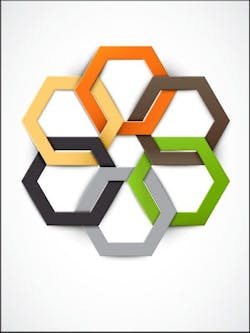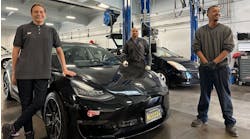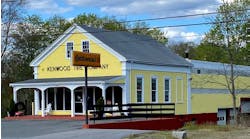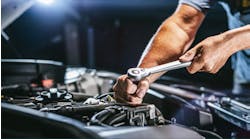On the surface, Green Garage and Foreign Accents are very different businesses—the two time zones, seven states and 1,611 miles separating them helps to clearly define that apparent gap.
Yet, both shops have nearly identical business philosophies, or at least, both companies were built with a focus on one concept: transparency.
“Trust always seems to be the biggest hurdle with building relationships with customers,” says Randy Beeninga, owner of Foreign Accents. “Being transparent eliminates all the fear. We have nothing to hide. We do our jobs right, we run our business right, and we want the customer to see that.”
Although they do it in very different ways, walk into either shop and it’s clear what these two businesses have done with their physical space to get that message across to their customers.
GREEN GARAGE
Two locations in Denver and Boulder, Colo.*
SIZE: 7,000 square feet STAFF: 10–12 MONTHLY CAR COUNT: 250–300
ANNUAL REVENUE: $750,000 (excluding all tire and product sales)
*Photos are from the Denver location
Branding Customer Service
She was a first-time customer, and Rob Organ, the shop manager for Green Garage, hadn’t met her before. So, you can understand if there was some worry when the customer said she wanted to discuss her hour-and-a-half wait for her car to be repaired.
“She said we had just made her day a whole lot happier,” Organ remembers. “She said she was able to get a leg-up on her day while waiting. She had a coffee, got online, was able to get into her work. She couldn’t have done that somewhere else.”
That experience, Organ says, is what separates Green Garage from many repair businesses across the country: “People really do enjoy being in here.”
Green Garage opened in 2009 in Boulder, Colo., the environmentally conscious, left-leaning town in the foothills of the Rocky Mountains. From Day 1, founder Ryan Ferrero says, the goal was to create a brand “that could take a modern look at the customer experience for servicing vehicles and repairing cars.” The idea was to use technology and newer sustainable business and repair concepts to create an all-new, holistic customer experience.
That experience, Organ says, is the ultimate focus of the business, which, since its official 2009 Boulder launch, has branched out to a Denver location as well.
Everything that sets Green Garage apart is clearly visible to any customer walking in the door
Shop Signs: Information as Foundation
Before opening, the Green Garage management team didn’t benchmark the shop concept against other repair industry leaders. Instead, they looked at Starbucks, Apple, Nordstrom’s—companies known for customer experience and, above all else, transparency in what they do.
Hence, the signs hung throughout the facility. Most noticeably, the ➊ “Wall of Smileage” outlines the business’s entire concept of sustainable vehicle ownership—with various eco-friendly driving products and materials surrounding it.
The concept is to demonstrate that customers don’t have to buy a car with a different powertrain to be eco-friendly; “It’s about education and information,” Organ says.
âž‹ All the signs in the customer area serve that purpose—in addition to presenting a clear, unified brand image through font, color and message choices. Consistency was a clear focus in the design.
The Restroom: (Don’t Forget Your Camera)
The management team toured more than 150 other facilities before beginning work on Green Garage. And after seeing how the majority of the industry operated in terms of the customer experience, they were inspired—to do the exact opposite.
With the help of Boulder-based OZ Architecture (which helped design much of the shop), Green Garage created a ➌ unique restroom, one as modern, clean and fresh as customers would expect in their own home.
“I wanted people to see it and want to take a picture,” Ferrero says. “I want people saying, ‘Oh, you’re going to Green Garage? You have to see their bathroom.’”
Basic Amenities: OK, How Green Are You?
Organ and the rest of the staff know that Green Garage’s name is bound to raise one question with skeptical customers: Well, how green are you?
And that’s why they left no stone (or piece of furniture) unturned: The âž? Adirondack chairs are each made from 500 recycled milk cartons; each of the chairs at the “Internet bar,” as they call it, are made of 100 recycled Coke bottles. There’s also a chandelier made from repurposed spark plugs.
“We have to be consistent with that concept of being green,” Organ says. “People need to be able to see it.”
The Café: A Destination Repair Shop
Yes, that’s a ➎ full-service coffee shop in Green Garage’s lobby. The company has a rent and licensing agreement with a local quick-service food company to manage and operate the space, and it provides customers with a unique way to relax while in Green Garage.
The idea is to create a shop that can also serve as a meeting space for people in the community.
“People have a meeting and get a coffee while getting their cars worked on,” Organ says. “The coffee shop also brings in its own separate clients, too, and that provides a chance to turn them into clients of our own.”
Creating a welcoming, neighborhood-hangout feel to the shop is one of the reasons the shop has an extremely high return rate among customers, believed to be just north of 90 percent.
The Shop Floor: Quiet, Please—There are Customers Waiting
The âž? large window looking into the shop floor is part of Green Garage’s transparency effort. The various eco-friendly products found throughout the work stations are an example of the shop’s commitment to its goals.
The rubber floor, though, that’s what really stands out.
“It’s made from 100 percent natural rubber,” Organ says. “It makes it a lot quieter for everyone working and for all the customers waiting. People aren’t going to be waiting around and hanging out if it’s too loud to hear the person next to them. Also, it’s a safer floor. There’s less slipping, and it’s easier on my [technicians’] legs and joints.”
FOREIGN ACCENTS
Greensboro, N.C.
SIZE: 7,800 square feet STAFF: 17 MONTHLY CAR COUNT: 500–600
ANNUAL REVENUE: $2.4 million
Rebuilt reputation
It’s not that it fell right into his lap, but, for Beeninga, perfect timing—and a little luck—certainly played a role.
For 21 years, Beeninga had successfully run his business, starting with a single shop as a 19-year-old in 1974. At the start of 1995, he and his brother (and business partner) Scott had 10 shops throughout North Carolina.
By the end of the year, they had one shop—one “perfect” shop.
“It was the year the [NFL’s Carolina] Panthers came to town, and business was booming in the area,” he says. “We had a group from Houston approach us about buying our two Charlotte locations.”
The price was right, so they sold.
And, suddenly, Beeninga saw an opportunity to completely redefine his business.
“Let’s just say we’d been around long enough to know what most customers think about our industry,” he says. “I’d seen it. Everyone’s seen it. So, I wanted to create a shop that would take the stigma away from auto repair.”
He sold the rest of his facilities, consolidating all his resources into a single location, which he tore down and rebuilt with his own personal design. The idea was to create a facility that would involve customers in the repair process—a shop, a business model that would build trust and customer relationships through transparency.
Waiting Area: Here to Serve
The front desk at Foreign Accents is likely different from any you’ve ever seen. First off, it’s actually two desks, laid out in a cockpit formation with an enormous glass wall behind it looking out into the shop floor.
The reason for this setup is simple: ➊ The front, half-circle-shaped desk is for customer service—that is, actually serving the customer (handling walk-ins, greeting customers, answering phones, signing papers, collecting payment, etc.); the âž‹ second desk in back is for the shop’s service staff to do their non-customer-related work (writing estimates, ordering parts, making phone calls, etc.)
With the amount of work pushed through the shop (upward of 600 vehicles per month), Beeninga always keeps both desks staffed with two employees to make sure each customer is handled appropriately.
Shop Layout: A Pathway to Trust
There’s nothing secretive about what happens in a repair shop; at least, Beeninga doesn’t feel there should be. And that thinking led to his designs for the shop floor.
“The entire goal—my whole thinking—was simply to eliminate customer fear,” he says. “And the best way I could do that was by letting them see everything, letting them be involved in it all.”
It’s why he put in the large glass wall looking into the shop. It’s also why he designed and built the ➌ center walkway through the shop.
“Customers can walk through anytime and not have to worry about tripping over cords or walking into something they shouldn’t,” he says. “They can walk right up to the mechanic working on their cars.”
The Bays: A Personalized Touch
Part of what makes the transparency approach work for Beeninga’s shop is the way he helps technicians connect with customers. Each technician is promoted as an individual expert in the company’s advertising. Print ads, radio spots, even the occasional TV commercial—Tom is your local Mercedes guy; Chris is your vintage guy; Chuck will handle your Subaru.
“We want people having a connection with each technician that’s fixing their car,” Beeninga says. “It helps customers feel comfortable, and it gives our guys a sense of pride.”
And âž? each technician is given two bays. Six techs, 12 bays—that’s how Beeninga wants it.
“We have experienced, high-level techs, and I’ve found this is the best way to keep their efficiency high,” he says. “They’re never sitting around waiting on a part, or waiting for their bay to be filled. They always have something to work on, and with the other car sitting there, it pushes them to get to it.”
Overall Look: Clean House
Although the name of the shop gives a decidedly “specialty” feel, Beeninga says his business philosophy is to fix every make and model. He wants all customers feeling like their vehicle belongs.
That’s a reason for the ➎ various flags hanging throughout the shop. Even though it’s just aesthetics, Beeninga says, you can make a customer feel welcome by improving what they see. After all, that’s usually all they ever know about your business, he says.
It’s why he keeps the shop floor spotless (he has designated people to mop it after each car is moved), and why he likes the personalized treatment from his technicians.
“We want people coming to us in the same way they would their barber or their bartender,” Beeninga says. “We want to be someone they trust, someone they want to see.”



